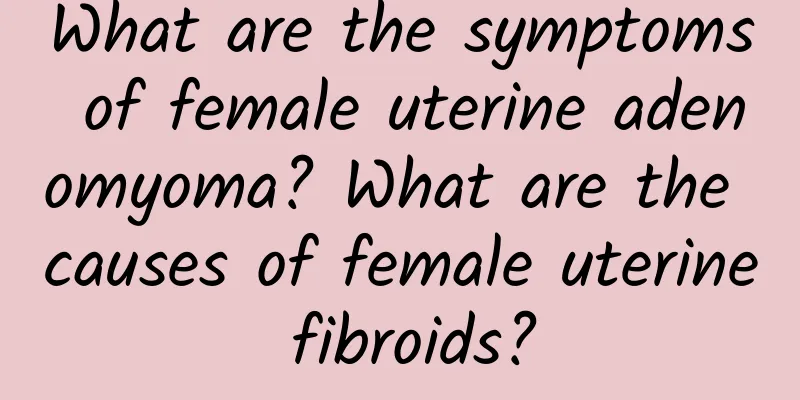What are the symptoms of female uterine adenomyoma? What are the causes of female uterine fibroids?

|
What are the symptoms of female uterine adenomyoma? What are the causes of female uterine fibroids? Uterine adenomyosis is a common gynecological disease that usually occurs in women of childbearing age. However, many patients know little about its symptoms and causes. This article will give you a detailed introduction to the symptoms and possible causes of female uterine adenomyosis, and list some common symptoms for your reference. 1. Symptoms of adenomyoma in women 1. Abnormal menstruation: One of the common symptoms of adenomyoma is abnormal menstruation. Patients may experience increased menstrual flow or shorter menstrual cycles. In some cases, patients may also experience prolonged menstruation, that is, menstruation lasting more than 7 days. 2. Abdominal pain and discomfort: Uterine adenomyosis can cause abdominal pain and discomfort. Patients may feel abdominal distension, bloating, or dull pain. The severity of the abdominal pain may vary depending on the size and location of the adenomyosis. 3. Pelvic compression symptoms: Large adenomyomas may compress surrounding tissues, leading to pelvic compression symptoms. Patients may experience symptoms such as frequent urination, urgency, constipation or diarrhea. 4. Infertility: Some female patients may experience infertility problems. Uterine adenomyosis can affect the implantation of fertilized eggs and in some cases may cause deformation of the uterine cavity, thereby increasing the risk of infertility. 5. Other symptoms: Some patients may also experience other symptoms, such as low back pain, feeling of heaviness in the lower abdomen, pain during sexual intercourse, etc. 2. Causes of uterine adenomyosis in women 1. Hormone imbalance: Hormone imbalance is a common cause of adenomyosis. The imbalance of estrogen and progesterone may lead to endometrial hyperplasia and muscle cell hyperplasia, forming fibroids. 2. Genetic factors: Genetic factors may also contribute to the occurrence of adenomyosis. Studies have shown that women with a family history of adenomyosis are more likely to develop the disease. 3. Other factors: Age, reproductive history and dietary habits are also related to the occurrence of adenomyosis. The older you are, the higher the risk. Women who have given birth to many children have a lower risk, while women who have no childbearing experience have a higher risk. High-fat and high-sugar dietary habits may also increase the risk. Uterine adenomyosis is a common gynecological disease in women, often accompanied by symptoms such as abnormal menstruation, abdominal pain and discomfort, pelvic compression symptoms, and infertility. Hormonal imbalance, genetic factors, and other factors such as age and reproductive history may all be causes of uterine adenomyosis. If women find the above symptoms, they should seek medical attention and receive necessary treatment in a timely manner. At the same time, regular physical examinations and maintaining a healthy lifestyle can also help prevent and reduce the occurrence of uterine adenomyosis. |
<<: What causes uterine fibroid pain? What to do if uterine fibroid pain
Recommend
Where is the abortion usually done?
Where is abortion usually performed? Generally sp...
Can cervical erosion develop into cervical cancer?
"Cervical erosion" troubles many female...
Medication options for ovulation bleeding
What are the medication options for ovulation ble...
What types of cervical erosion can be divided into according to the manifestations
Cervical erosion is a common condition of the fem...
What's wrong with having two periods in one month?
What's wrong with having two periods in one m...
Common causes of vulvar leukoplakia
What are the main causes of common vulvar leukopl...
What should pregnant mothers do if they have cervical erosion? Learn 5 health care measures to prevent cervical erosion during pregnancy
For expectant mothers, pregnancy is a happy and d...
Does pressing your thumb to induce menstruation work?
The question of whether thumb pressing is effecti...
How to prevent leakage during abortion
Missed aspiration is one of the possible complica...
Healthy food! Lentil weight loss recipe
When dining in Korea, there are usually side dish...
Nursing measures for female cervical warts
Nowadays people are under great pressure in life,...
Bacterial vaginosis can cause infertility
Bacterial vaginosis is caused by bacterial infect...
Will two medical abortions affect pregnancy again? See what the doctor says
If a woman has two abortions with medicine, she c...
How can women prevent endometrial thickening?
Endometrial hyperplasia is the thickening of the ...
Women need to know the symptoms of cervical erosion
Among gynecological diseases, cervical erosion is...









